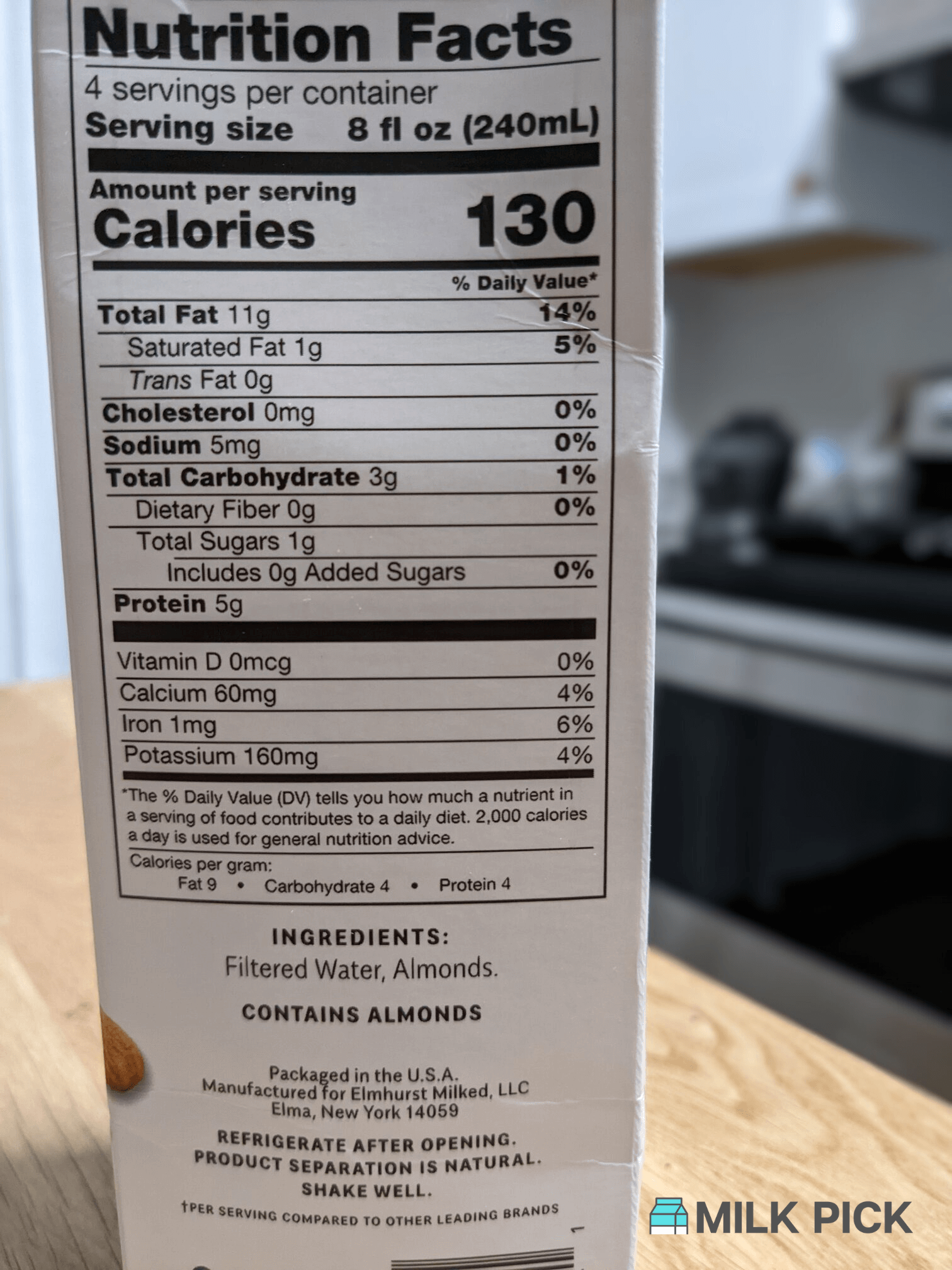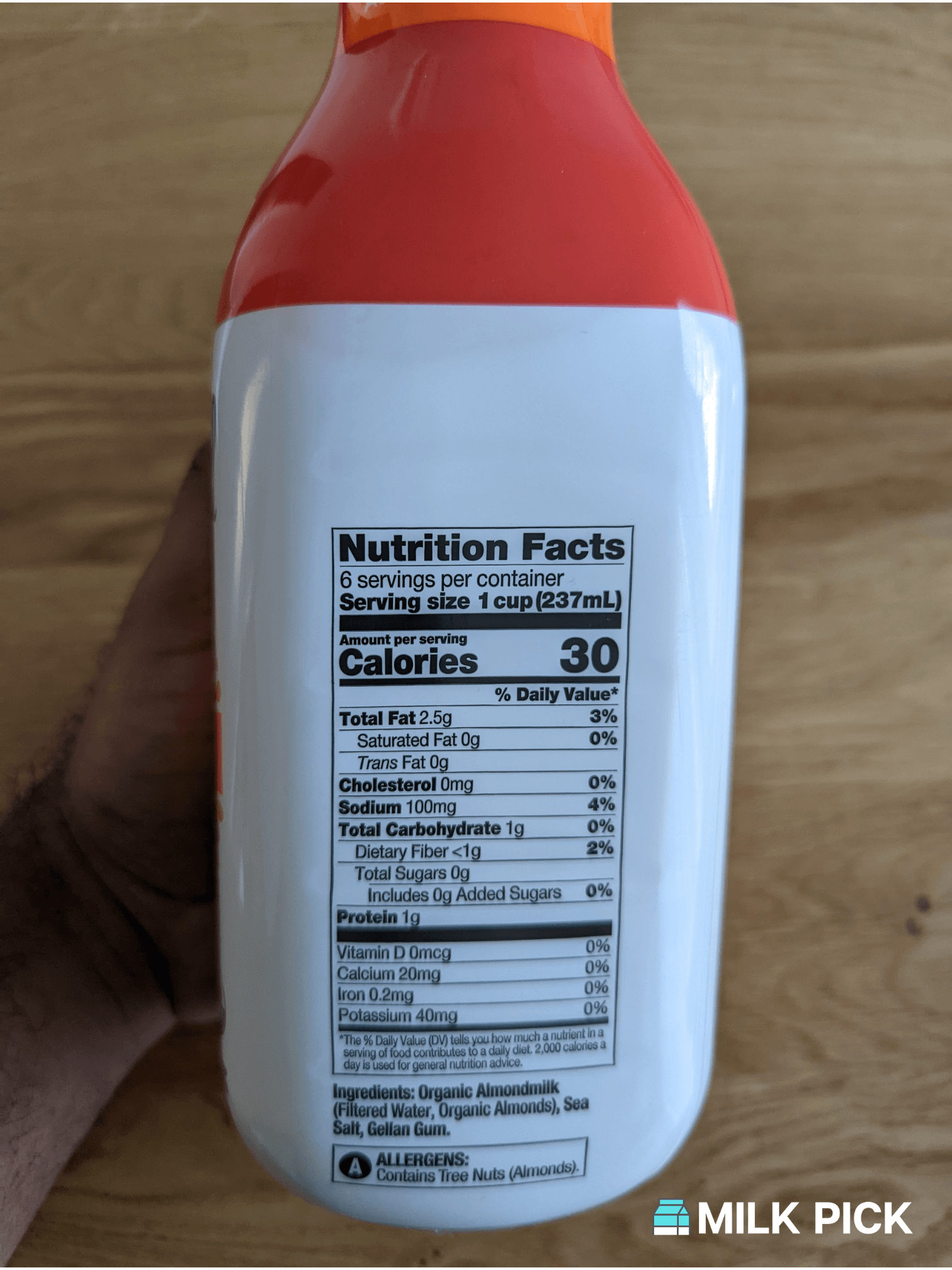We include nutritional facts for different types of milk in our content. This information includes calories, macronutrients (protein, fats, carbs), and vitamins found in milk.
This information comes from the USDA FoodData Central. However, it’s important to understand where the USDA’s data comes from because it may not accurately reflect the nutritional breakdown of the milk you’re drinking.
The nutritional information for most products in the USDA database comes from a combination of manufacturer data and estimates.
In other words, they use nutritional information from a single brand for a product and mathematical equations to estimate their nutritional data.
For example, here is the nutritional information listed on the USDA website for one cup of plain, unsweetened almond milk.

If you look at the back of the almond milk you regularly drink, you’ll likely notice the values are different.
For instance, here are the nutritional values for two different almond milk brands:


Both contain nearly the same ingredients (besides the gellan gum and sea salt), yet Elmhurst has:
- 4x more calories
- 4x more fat
- 3x more carbs
- 5x more protein
- 3x more calcium
- 4x more potassium
So what’s the deal?
Why Do Nutrition Facts For Plant-Based Milk Vary So Much?
The difference primarily comes down to the ingredients. While most plant-based milk has simple ingredients—a base (almonds, oats, peas, etc.) and water—the ratios can vary drastically.
To be more specific, some brands put more almonds, oats, cashews, etc., into their milk than other brands.
That’s why, for instance, brands like Three Trees and Elmhurst have more calories than Almond Breeze or other popular almond milk companies. They use more whole almonds in their recipe, meaning more nutrients pass through to your milk.
This is also why some brands tend to charge more for their products.
When you see almond milk with 30-40 calories per serving, it’s because it contains very few almonds. The same goes for oat milk, cashew milk, or any other type of plant-based milk.
This doesn’t necessarily mean lower-calorie plant-based milk is inherently “bad.” It just means that it contains more water than other brands.
But there is a downside.
The Dark Side of Low-Calorie Plant Milk
One of the benefits of using more almonds, oats, and cashews in plant-based milk is that it naturally gives you a creamier and thicker consistency.
You can try this at home. Compare almond milk made with a tablespoon of almonds vs. a whole cup (with the same amount of water). You’ll notice a significant difference in color and consistency.
The less base you use, the more watery the final product is. To prevent selling watery almond milk, manufacturers often include additives to thicken the consistency of their milk.
When you see ingredients like gellan gum, sunflower oil, and similar emulsifiers, it’s usually because the product doesn’t contain many almonds or oats. Those added ingredients are used to change the consistency of the product to give it a creamier texture that mimics cow’s milk.
You’ll rarely see a low-calorie plant-based milk that doesn’t include an emulsifier.
Our Suggestion
For now, we’ve chosen to include the USDA nutrition facts in our articles because it’s the most comprehensive data available.
However, when buying plant-based milk, we recommend you read the nutrition facts to know exactly what you’re getting.
Many of our favorite brands don’t contain any filler ingredients. As a result, they have more calories and nutrients than you’ll see in the USDA database.
Unfortunately, it’s difficult to include nutritional facts for homemade plant-based milk because we don’t know how much nutrients are retained after the straining process.
Long story short, nutritional data for plant-based milk will vary, and that’s ok. Check the nutritional label on the back of any milk you buy to know exactly what’s in it.
Our general recommendation is to stick with products with minimal ingredients (ideally just a base and water).
Hopefully, that gives you more insights into where the nutritional data in our articles comes from and why it may differ from the brands you buy.
If you have any questions, feel free to contact us anytime!

